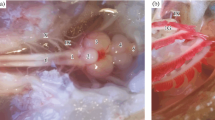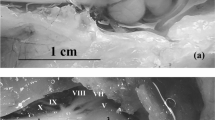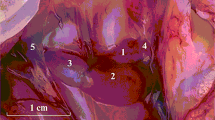Abstract
The activities of cytosolic oxidoreductases (malate and lactate dehydrogenases) and the level of ATP production in the hypoxic resistive tissues of Scorpaena porcus Linnaeus, 1758 were studied. It was found that “oxyphilic” tissues (structures of the brain, gills) are pre-adapted to hypoxia, since under normal conditions they had high MDH activity and an increased MDH/LDH ratio, the value of which was 10 to 20 times higher than that in the liver and white muscles. Moreover, in the relatively “young” brain divisions (forebrain, diencephalon, midbrain) the aerobic pathway of carbohydrate metabolism predominated. The ATP content decreased in a line of examined tissues as follows: white muscles → liver → medulla oblongata → gills → forebrain, diencephalon and midbrain. The ATP level in white muscles was an order of magnitude higher than in “oxyphilic” tissues and it probably served for the provision of throwing strategy for hunting of bottom predator.



Similar content being viewed by others
REFERENCES
Almeida-Val, V.M. and Hochachka, P.W., Air-breathing fishes: metabolic biochemistry of the first diving vertebrates, in Biochemistry and Molecular Biology of Fishes, Hochachka, P.W. and Mommsen, T., Eds., Amsterdam: Elsevier, 1995, vol. 5, pp. 45–55. https://doi.org/10.1016/S1873-0140(06)80029-9
Almeida-Val, V.M., Farias, I.P., Silva, M.N., et al., Biochemical adjustments to hypoxia by Amazon cichlids, Braz. J. Med. Biol. Res., 1995, vol. 28, nos. 11–12, pp. 1257–1263.
Daxboeck, C., Davie, P.S., Perry, S.F., and Randall, D.J., Oxygen uptake in a spontaneously ventilating, blood-perfused trout preparation, J. Exp. Biol., 1982, vol. 101, pp. 35–45.
Emeretli, I.V., Dependence of the activity of enzymes involved into energy metabolism of the Black Sea fishes on temperature at different periods of a year, Vopr. Ikhtiol., 1994, vol. 34, no. 3, pp. 395–399.
Gray, I.E., Comparative study of the gill area of marine fishes, Biol. Bull., 1954, vol. 107, pp. 219–225.
Hochachka, P.W. and Somero, G.N., Biochemical Strategies in Environmental Adaptation, Philadelphia: Saunders, 1973.
Hochachka, P.W. and Somero, G.N., Biochemical Adaptation: Mechanism and Process in Physiological Evolution, Oxford: Oxford Univ. Press, 2002.
Hochachka, P.W., Buck, L.T., Doll, C.J., and Land, S.C., Unifying theory of hypoxia tolerance: molecular/metabolic defense and rescue mechanisms for surviving oxygen lack, Proc. Natl. Acad. Sci. U.S.A., 1996, vol. 93, pp. 9493–9498. https://doi.org/10.1073/pnas.93.18.9493
Holm-Hansen, O. and Booth, C.R., The measurement of adenosine triphosphate in the Ocean and its ecological significance, Limnol. Oceanogr., 1966, vol. 11. №. 4, pp. 510–519.
Houlihan, D.F., Mathers, E.M., and Foster, A., Biochemical correlates of growth rate in fish, in Fish Ecophysiology, Rankin, J.C. and Jensen, F.B., Eds., London: Springer-Verlag, 1993, pp. 45–71.
Ip, Y.K. and Low, W.P., Lactate production in the gills of the mudskipper Periophthalmodon schlosseri exposed to hypoxia, J. Exp. Zool., 1990, vol. 253, no. 1, pp. 99–101. https://doi.org/10.1002/jez.1402530113
Johansen, K. and Pettersson, K., Gill O2 consumption in a teleost fish, Gadus morhua, Respir. Physiol., 1981, vol. 44, pp. 277–284. https://doi.org/10.1016/0034-5687(81)90023-2
Kawal, H.G., Torres, J.J., Sidell, B.D., and Somero, G.N., Metabolic cold adaptation in Antarctic fishes: evidence from enzymatic activities of brain, Mar. Biol., 2002, vol. 140, pp. 279–286. https://doi.org/10.1007/s002270100695
Klyashtorin, L.B., Vodnoe dykhanie i kislorodnye potrebnosti ryb (Aquatic Respiration and Oxygen Consumption by Fishes), Moscow: Legkaya Pishchevaya Prom-st’, 1982.
Leibson, L. and Plisetskaya, E.M., Effect of insulin on blood sugar level and glycogen content in organs of some cyclostomes and fish, Gen. Comp. Endocrinol., 1968, vol. 11, no. 2, pp. 381–392. https://doi.org/10.1016/0016-6480(68)90095-6
Lushchak, V.I., Bahnjukova, T.V., and Storey, K.B., Effect of hypoxia on the activity and binding of glycolytic and associated enzymes in sea scorpion tissues, Braz. J. Med. Biol. Res., 1998, vol. 31, no. 8, pp. 1059–1067. https://doi.org/10.1590/s0100-879x1998000800005
Lutz, P.L., Mechanisms for anoxic survival in the vertebrate brain, Ann. Rev. Physiol., 1992, vol. 54, pp. 601–618. https://doi.org/10.1146/annurev.ph.54.030192.003125
Mil’man, L.S., Yurovetskii, Yu.G., and Ermolaeva, L.P., Activity of key enzymes of hydrocarbon metabolism, in Metody biologii razvitiya (Practical Manual on Development Biology), Moscow: Nauka, 1974, pp. 346–364.
Mommsen, T.P., Metabolism of the fish gill, in Fish Physiology, Vol. 10: Gills, Part B: Ion and Water Transfer, Hoar, W.S. and Randall, D.J., Eds., London: Academic, 1984a, pp. 203–238.
Mommsen, T.P., Biochemical characterization of the rainbow trout gill, J. Comp. Physiol., 1984b, vol. 154, no. 2, pp. 191–198.
Nilsson, G.E. and Östlund-Nilsson, S., Does size matter for hypoxia tolerance in fish? Biol. Rev., 2008, vol. 83, pp. 173–189. https://doi.org/10.1111/j.1469-185X.2008.00038.x
Ovchinnikova, S.I. and Timakova, L.I., Seasonal, sexual, and species-dependent features of bioenergetic state of white muscles of the cod and flounder, Vestn. Murmansk. Gos. Tekh. Univ., 2008, vol. 11, no. 3, pp. 432–437.
Panepucci, L., Fernandes, M.N., Sanches, J.R., and Rantin, F.T., Changes in lactate dehydrogenase and malate dehydrogenase activities during hypoxia and after temperature acclimation in the armored fish, Rhinelepis strigosa (Siluriformes, Loricariidae), Rev. Bras. Biol., 2000, vol. 60, no. 2, pp. 353–360. https://doi.org/10.1590/s0034-71082000000200021
Payan, P., Girard, J.P., and Mayer-Gostan, N., Branchial ion movements in teleosts: the role of respiratory and chloride cells, in Fish Physiology, Vol. 10: Gills, Part B: Ion and Water Transfer, Hoar, W.S. and Randall, D.J., Eds., London: Academic, 1984, pp. 39–63. https://doi.org/10.1016/S1546-5098(08)60181-8
Polakof, S. and Soengas, J.L., Involvement of lactate in glucose metabolism and glucosensing function in selected tissues of rainbow trout, J. Exp. Biol., 2008, vol. 211, pp. 1075–1086. https://doi.org/10.1242/jeb.014050
Polakof, S., Míguez, J.M., and Soengas, J.L., In vitro evidences for glucosensing capacity and mechanisms in hypothalamus, hindbrain, and Brockmann bodies of rainbow trout, Am. J. Physiol.: Regul. Integr. Comp. Physiol., 2007, vol. 293, pp. R1410–R1420. https://doi.org/10.1152/ajpregu.00283.2007
Polakof, S., Mommsen, T.P., and Soengas, J.L., Glucosensing and glucose homeostasis: from fish to mammals, Comp. Biochem. Physiol., Part B: Biochem. Mol. Biol., 2011, vol. 160, pp. 123–149. https://doi.org/10.1016/j.cbpb.2011.07.006
Sahin, C., Erbay, M., Kalayci, F., et al., Life-history traits of the black scorpionfish (Scorpaena porcus) in southeastern Black Sea, Turk. J. Fish. Aquat. Sci., 2019, vol. 19, no. 7, pp. 571–584. https://doi.org/10.4194/1303-2712-v19_7_04
Shulman, G.E. and Love, R.M., The biochemical ecology of marine fishes, in Advances in Marine Biology, San Diego: Academic, 1999, vol. 36.
Silkin, Yu.A., Silkina, E.N., Chernyaeva, V.N., and Vasilets, V.E., Study of dimensional and morphological characteristics of erythrocytes in some Black Sea fish of different evolution position and ecological specialization, J. Ichthyol., 2019, vol. 59, no. 1, pp. 97–103. https://doi.org/10.1134/S0032945219010168
Skorkowski, E.F., Mitochondrial malic enzyme from crustacean and fish muscle, Comp. Biochem. Physiol., Part B: Biochem. Mol. Biol., 1988, vol. 90, pp. 19–24.
Soengas, J.L. and Aldegunde, M., Energy metabolism of fish brain, Comp. Biochem. Physiol., Part B: Biochem. Mol. Biol., 2002, vol. 131, no. 3, pp. 271–296. https://doi.org/10.1016/s1096-4959(02)00022-2
Soldatov, A.A., Organ blood flow and vessels of microcirculatory bed in fish (review), J. Evol. Biochem. Physiol., 2006, vol. 42, no. 3, pp. 243–252. https://doi.org/10.1134/S002209300603001X
Soldatov, A.A., Andreeva, A.Yu., Novitskaya, V.N., and Parfenova, I.A., Coupling of membrane and metabolic function in nucleated erythrocytes of Scorpaena porcus under hypoxia in vivo and in vitro, J. Evol. Biochem. Physiol., 2014, vol. 50, no. 5, pp. 409–415. https://doi.org/10.1134/S0022093014050056
Sollid, J. and Nilsson, G.E., Plasticity of respiratory structures—adaptive remodeling of fish gills induced by ambient oxygen and temperature, Respir. Physiol. Neurobiol., 2006, vol. 154, pp. 241–251. https://doi.org/10.1016/j.resp.2006.02.006
Tripathi, G. and Singh, H., Impact of alphamethrin on biochemical parameters of Channa punctatus, J. Environ. Biol., 2013, vol. 34, pp. 227–230.
Trusevich, V.V., Phosphorous metabolism during floating of fishes, in Elementy fiziologii i biokhimii obshchego i aktivnogo obmena u ryb (Elements of Physiology and Biochemistry of General and Active Metabolism in Fishes), Kiev: Naukova Dumka, 1978, pp. 145–167.
Tseng, Y.C., Liu, S.T., Hu, M.Y., et al., Brain functioning under acute hypothermic stress supported by dynamic monocarboxylate utilization and transport in ectothermic fish, Front. Zool., 2014, vol. 11, no. 53. https://doi.org/10.1186/s12983-014-0053-1
Funding
The study was carried out within the framework of state tasks no. 0828-2019-0003, 0828-2019-0005 and with the support of the Russian Foundation for Basic Research, project no. 20-44-920001 (data on oxyphilic tissues).
Author information
Authors and Affiliations
Corresponding author
Ethics declarations
Conflict of interests. The authors declare that they have no conflict of interest.
Statement on the welfare of animals. All applicable international, national, and/or institutional guidelines for the care and use of animals were followed.
Additional information
Translated by V. Mittova
Rights and permissions
About this article
Cite this article
Soldatov, A.A., Golovina, I.V., Kolesnikova, E.E. et al. Tissue Peculiarities of Energy Metabolism Enzyme Activity and ATP Content In Black Sea Ruff Scorpaena porcus (Scorpaenidae). J. Ichthyol. 61, 299–306 (2021). https://doi.org/10.1134/S0032945221010161
Received:
Revised:
Accepted:
Published:
Issue Date:
DOI: https://doi.org/10.1134/S0032945221010161




